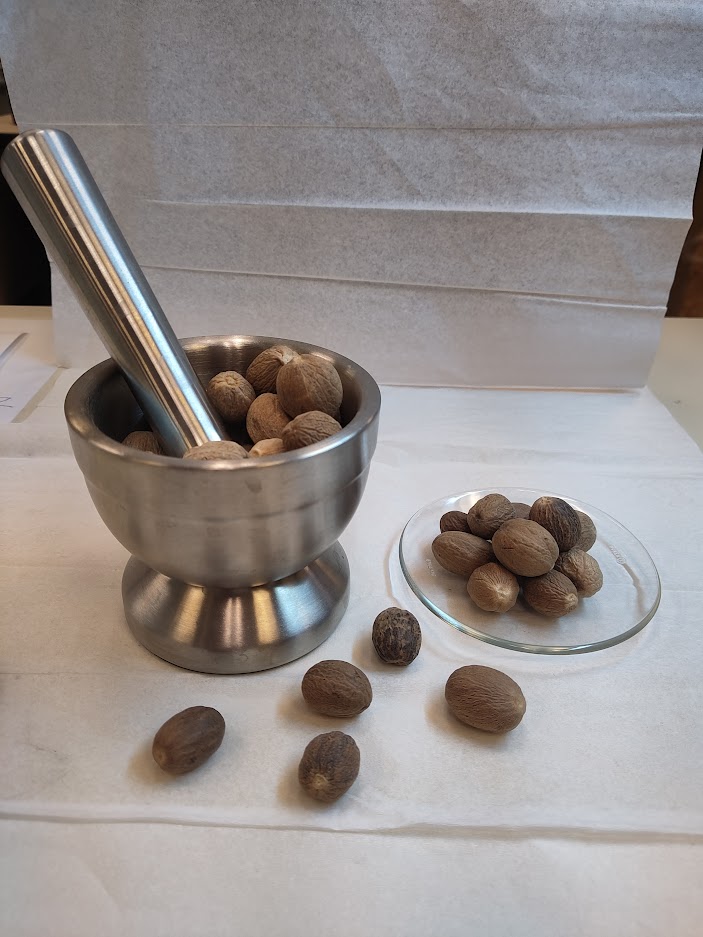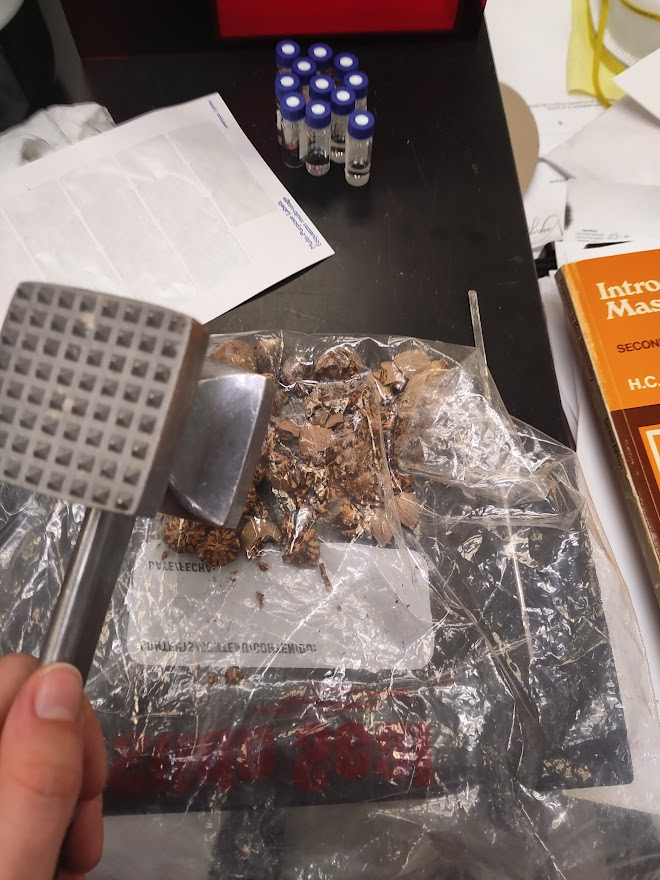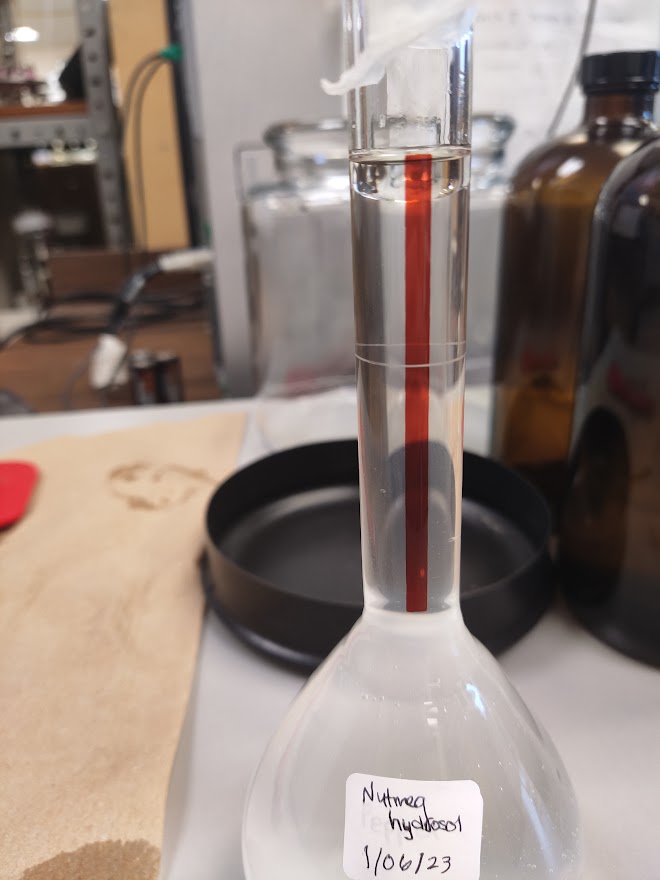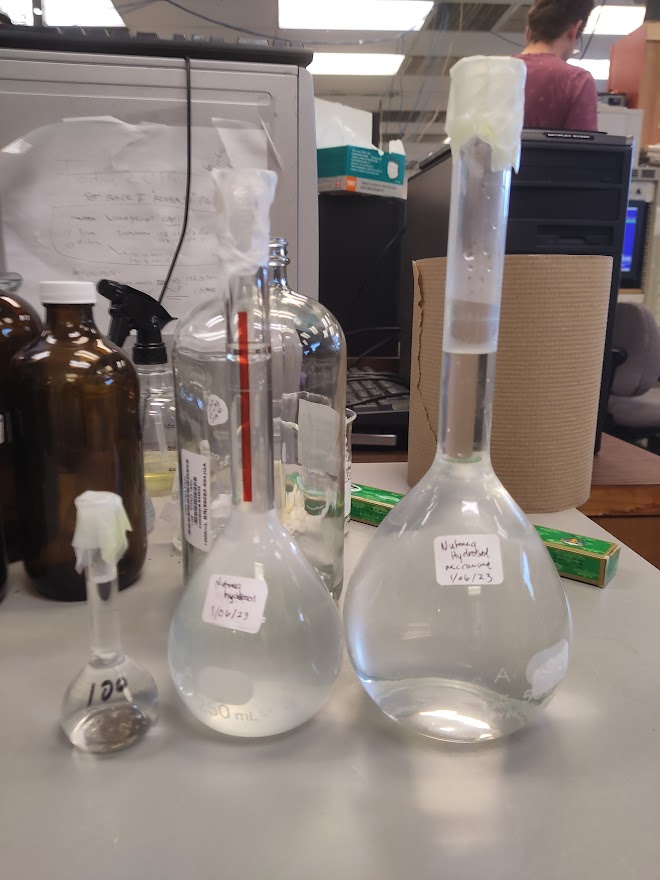
Nutmeg Hydrosol
Nutmeg is the pit of the nutmeg tree fruit. The household spice is made by grinding the dried nutmeg seed into a fine powder. The spice has a pungent, distinctive, warm, sweet taste. It is used to flavour many baked goods such as pies, pudding, cakes, as well as other things such as cranberry sauce and eggnog.

Nutmeg has been used for over 3500 years. For most of that time, the sole source of nutmeg was its native habitat, the Banda Islands, a part of the Maluku Islands in Indonesia. Around 500 CE, nutmeg spread to India and Constantinople through trade. However, it wasn’t until the 1400s when Arab traders pinpointed the source of nutmeg, but the location was still unknown to European traders at this point. In the 1600s, the Dutch East India company waged war on the Bandanese, killing, torturing, and enslaving more than 14000 of the original 15000 Bandanese people, in order to gain control of the spice trade.
Nutmeg is also known for its hallucinogenic effects if consumed in large amounts, along with dizziness, tachycardia, dry mouth, blurred vision, and other side effects. Nutmeg poisoning can even cause death at very high amounts, particularly if consumed with other substances.

CREATION OF NUTMEG HYDROSOL
The nutmeg hydrosol was created using microwave extraction. 101.5g of nutmeg was crushed with a hammer and then blended into a coarse powder using a standard blender. At this point, the nutmeg had a very strong medicinal, peppery scent. The blended nutmeg was then transferred to the microwave distillation vessel along with 200mL of water and left to soak overnight. The next day, an ice cone was fitted to the lid of the extraction vessel, and a 250mL beaker was placed in the centre. The vessel was microwaved on high power for 9 minutes. The liquid collected in the beaker was then transferred to a volumetric flask, and a new ice cone was fitted to the lid. This process was then repeated twice more.

A total of 750mL of hydrosol was created. The scent of the hydrosol is earthy and slightly sweet. Approximately 1.5mL of nutmeg essential oil was also produced from the nutmeg distillation. The oil formed a clear layer on top of the hydrosol. The hydrosol itself was slightly cloudy, likely due to dispersion of oil within it. It was left overnight to allow any oil droplets to rise to the top. The essential oil was then carefully pipetted off the top and put into a separate vial.

ANALYSIS OF HYDROSOL
The collected hydrosol was first run through a solid phase extraction in order to remove the water from the distillate as well as any large impurities which may damage the GC column. The hydrosol sample was then run on the GC-MS in order to identify and quantify the compounds within it.
The primary constituent of the nutmeg hydrosol was found to be terpinen-4-ol, at a concentration of 0.12g/L. Terpinen-4-ol is known to have a spicy, mentholic, earthy scent and is also found in high concentrations in tea tree oil. This likely contributes to the medicinal scent of the crushed nutmeg. Myristicin is also found in the nutmeg hydrosol, at a concentration of 0.07g/L. This is the compound thought to be responsible for the hallucinogenic effects of nutmeg, as it is likely converted in the body into MMDA, a psychedelic.
Seneme EF, Dos Santos DC, Silva EMR, Franco YEM, Longato GB. Pharmacological and Therapeutic Potential of Myristicin: A Literature Review. Molecules. 2021 Sep
29;26(19):5914. doi: 10.3390/molecules26195914. PMID: 34641457; PMCID: PMC8512857.
ANALYSIS OF ESSENTIAL OIL
The essential oil produced from the microwave extraction of nutmeg was also analyzed. 1μL of the essential oil was diluted with 1mL of ethyl acetate and run through the GC-MS. Essential oils are significantly more complicated when compared to the hydrosols, which is evident by glancing at their chromatograms.
The primary constituent of the nutmeg essential oil is sabinene, comprising 36.5% of the oil. Sabinene is a terpene with a spicy, sharp scent. This combined with the terpinene-4-ol likely contribute greatly to the intense medicinal smell of crushed nutmeg. α-pinene and β-pinene are both present in high amounts in the essential oil as well, making up 14.8% and 12.5% of the oil respectively.
CONCLUSIONS
While producing the nutmeg hydrosol, a significant amount of essential oil (1.5mL) was produced from a relatively low amount of starting material (101.5g). The hydrosol was composed of mainly terpinen-4-ol, at a concentration of 0.12g/L. The essential oil also contained terpinene-4-ol, with it making up 2.9% of the oil, however the main compound in the nutmeg essential oil is sabinene. Sabinene comprises 36.5% of the oil. While myristicin is present in both the oil (1.9%) and the hydrosol (0.07g/L), it is at a very low concentration, meaning that an accidental ingestion of a small amount of the hydrosol would not be likely to cause hallucinogenic or other hazardous effects attributed to myristicin. The nutmeg hydrosol is peculiar as it is more complex than other hydrosols analyzed, containing more than 10 compounds. For this reason, nutmeg hydrosol would not be a good candidate for simple purification of any one of these compounds. However, the hydrosol could have culinary and aromatherapy applications.
